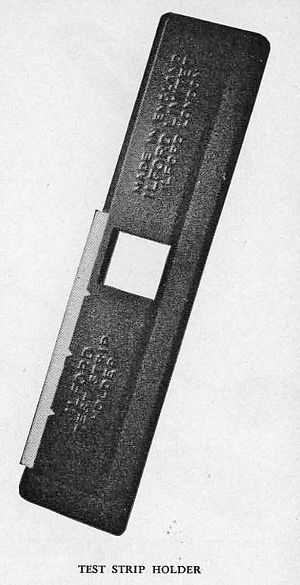|
The Ilford Test Strip Holder
was a device intended to assist with determining the optimum
printing time exposure to use when making an enlargement.
It consists of two pieces of
metal strip, secured together but separated sufficiently for
a an off-cut piece of enlarging paper to be inserted, its light
sensitive side showing through the opening at the centre of the
holder. The length of the paper needs to be a slightly more than
4 times the length of the opening. The width of the paper needs
to exceed the width of the sheath by a small amount, so that
the paper can be slid along by an amount that can be judged using
the notches in the side of the top metal piece.
The light sensitive paper would
be inserted into the holder using the darkroom safelight and
placed on the enlarger baseboard at a position such that the
cut-out window was exposed to an important p[art of the image.
The enlarger light would then be turned on for, say, 5seconds.
The enlarger light would then be turned off and the paper slid
along one 'notch', bringing an unexposed section of paper into
line with the holder's opening. With the holder still positioned
at the same place on the enlarger baseboard, a second exposure
could then be made, of, say, 10seconds. This process would then
be repeated a further two times, giving a resulting test strip
showing, after procesing, the same section of print, but with
exposures of e.g. 5seconds, 10seconds, 20 seconds and 40seconds.
Once fixed and given a brief wash, the test strip could be examined
in white light and the exposure for a complete print judged from
the results of the test strip.
This device appears in Ilford
equipment catalogues of the early 1950s, priced at 2s.4d (12p).
The 1953 catalogue describes it as:
"Consists of a metal sheath
into which a strip of sensitised paper is inserted. The aperture
is then positioned to the portion of the image for which exposure
information is required, and the first exposure is given. The
strip of paper is then moved along for an arranged distance,
and in this way a series of "stepped" exposures can
be made. The strip of paper is then developed and inspected in
white light, when the correct exposure can be decided."
The image below has been provided
by Tony Pritchard.
|
 |